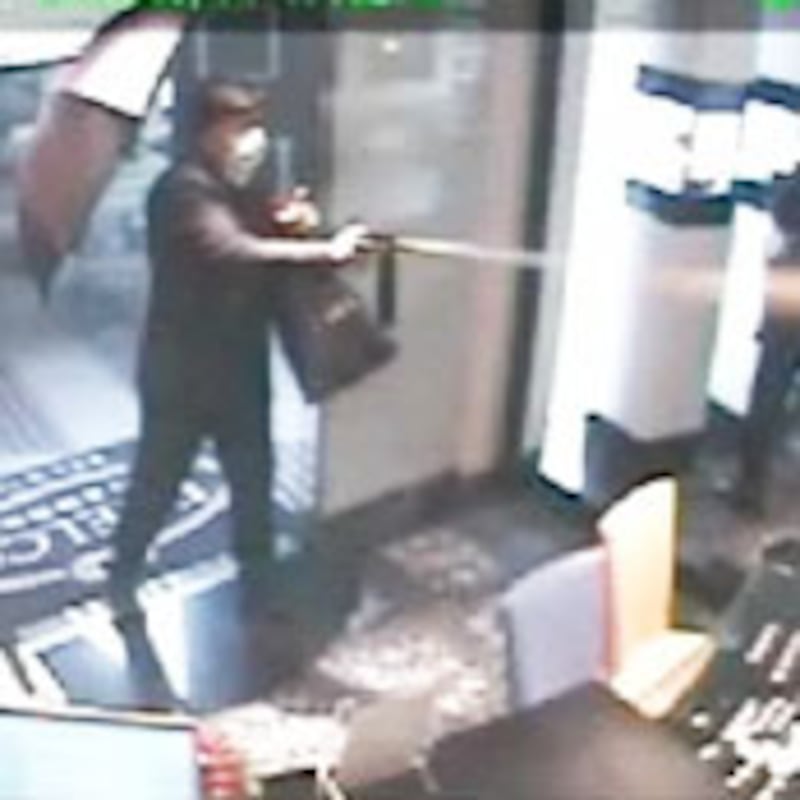
In a seedy Paris neighborhood famous for the Moulin Rouge, strip clubs, and British pubs, you might not expect to find a pair of flamboyant multimillion-dollar jewel thieves in a nondescript hotel. But, as any fan of the Pink Panther films knows—and as police around the world are learning—jewel thieves are full of surprises.
The two men arrested in Pigalle Monday could certainly have afforded better digs if, as police suspect, they are big fish in an international burglary ring that has taken its moniker from the films: The Pink Panthers. Less than a week earlier, the two allegedly walked out of L’Emeraude bijouterie in Lausanne, Switzerland, with $2 million in luxury watches.
Police believe the four busty ladies, who entered Harry Winston’s in Paris drew out a Magnum and a grenade and made off with an astounding $100 million in jewelry, were Panthers in drag.
ADVERTISEMENT
One of them, Zoran Kostic, is thought to be among "the godfathers of the Pinks,” according to French police. He and his Croatian collaborator, Nicolai Ivanovic, are the subject of numerous international arrest warrants, including one for a large jewelry store robbery in Monaco in 2007.
Overall, the Pink Panthers gang, 200-or-so-strong and made up largely of former military men from the Balkans, is believed to have staged more than 120 heists in at least 30 countries over the past decade. The estimated total haul: around $200 million, which is the kind of money that usually merits a room at the Ritz or the George V.
Scotland Yard dubbed the gang “the Pink Panthers” after discovering a stolen blue-diamond ring worth about $750,000 in a jar of skin cream in the possession of one of the thieves, echoing a scene in a Blake Edwards film. The Panthers don’t merely echo films, like The Thomas Crown Affair, they improve on them. As a French investigator explained it to Agence-France Press, the Panthers’ modus operandi is "ballsy, and meticulously prepared.”
Their signature is the audacious, tightly choreographed lightning-strike robbery. In 2005, Panthers in St. Tropez on the Côte d'Azur dressed in loud tourist T-shirts, hit a store near the waterfront, then strolled through the tourist-thronged streets—impassable to cars—to a waiting speedboat. In other well-planned getaways, they’ve used bicycles and even skis.
Their £23 million “Crime of the Century” in London in 2003 fascinated the U.K., in part because the criminals walked by countless surveillance cameras after grabbing the loot without bothering to cover their faces. (A few were detained in that case, including the man with the diamond ring in a jar of cream. Others got away.) In another U.K. heist, in 2007, they drove up in a chauffered Bentley Continental Flying Spur and pretended to be wealthy enough for the prestigious diamond seller Graff to treat them like valued customers—until one thief whipped out a Magnum.
In Tokyo, they appeared to be average businessmen bicycling to work in hygienic facemasks—until they tear-gassed jewelry staff and walked out with a million-dollar bootie.
The most ostentatious robbery might have involved the four busty ladies who entered Harry Winston’s in Paris, drew out a Magnum and a grenade, and made off with an astounding $100 million jewel cache in December 2008. The police believe the perps were Panthers in drag.
But perhaps the most vivid heist came in Dubai in 2007, inside a huge shopping mall made largely of marble. Two men drove impeccable high-cylinder Audis into the façade of the Emirates’ most expensive jewelry shop and made off with $13 million in baubles. (Surveillance video of that robbery, not surprisingly, is an online favorite).
In March, Interpol brought its national investigators from 16 countries together in Monaco for a third meeting about the “Pinks,” who are believed to take orders from a few dozen men in Belgrade and Zagreb. (Lausanne, the latest victim, is expected to join the next meeting.) The gang’s resourcefulness, creativity, and mobility—their sense that the world “is their hunting ground,” as a French investigator recently described it—has made it difficult for police in any one country to slow the Panthers, although there have been arrests in both Asia and Europe.
Some of those happened thanks to dumb luck. In Monaco, a car ran over the foot of a Serbian pedestrian who was recognized at the hospital from an Interpol “Wanted” listing in connection with the Dubai heist. A tip from Swiss authorities allowed French police to find Kostic and Ivanovic in their obscure Parisian hotel.
In April, the French television show Sept à Huit traveled to Podgorica, Montenegro, one of several Balkan cities where Panthers are believed to have invested heavily in real estate (using cash, of course). Among other suspected Panthers, it is home to a man who served hard time after British police found that ring hidden in skin cream. The man, who has since become the owner of a supermarket in Podgorica—with honest money, he insists—took umbrage at the suggestion that the Panthers’ brilliantly scripted crimes were inspired by Hollywood. "All of this because they found something in a jar. Yeah, right,” he said, dismayed.
Wearing a bright pink shirt in a city where residents prefer to duck questions about Panthers, whether retired or active, he sought to clarify: “They said that I copied a film. But there is no film; there is nothing. I just did it [the crime] like that, but everyone talks about the Pink Panthers!"
The talk isn’t likely to end any time soon.
Eric Pape has reported on Europe and the Mediterranean region for Newsweek magazine since 2003. He is co-author of the graphic novel, Shake Girl, which was inspired by one of his articles. He is based in Paris.






